Land Concentration and Land Grabbing Processes—Evidence from Slovakia
Abstract
:1. Introduction
- The purchase of land with the aim of depositing capital while the acquirer is not primarily motivated by the agricultural use of the land;
- The acquisition of land ownership by entities conducting business in agriculture and accumulating their ownership in order to strengthen their competitive position and to take control over the economic chain starting from primary production through processing up to placement in the market.
2. Materials and Methods
3. Results
3.1. Historical Milestones towards Land Concentration
- 8.4 million ownership parcels;
- 4.4 million owners and 100.7 million co-ownership relations;
- An average of 11.93 owners of one parcel;
- 22.73 parcels owned by one owner.
3.2. Land Concentration in Ownership and Tenure Relationships
3.3. Land Concentration towards Land Grabbing?
- Acquisition of property rights necessary for ensuring public interest, i.e., the needs of society, state food security, development of the national economy, and public interest;
- Legitimate entities in terms of agricultural land acquisition.
- The District Office in the site of the Self-Government Region in the area of general agricultural land quality protection pursuant to the Act No. 220/2004 Coll. (Figure 10);
- The Central Control and Testing Institute in Agriculture in specialised areas (fertilisers, seeds, testing, etc.).
4. Discussion and Conclusions
Author Contributions
Funding
Institutional Review Board Statement
Informed Consent Statement
Data Availability Statement
Conflicts of Interest
References
- Lauterpacht, H. The Universal Declaration of Human Rights. Brit. YB Int.’l L. 1948, 25, 354. [Google Scholar]
- Azadi, H.; Vanhaute, E. Mutual Effects of Land Distribution and Economic Development: Evidence from Asia, Africa, and Latin America. Land 2019, 8, 96. [Google Scholar] [CrossRef] [Green Version]
- Larson, J.B.M. Land Ownership and Property Rights. In PUBLIC POLICY IN FOOD AND AGRICULTURE; The Pensylvania State University: State College, PA, USA, 2009; pp. 248–257. [Google Scholar]
- Libecap, G.D. The Consequences of Land Ownership. Available online: https://www.hoover.org/research/consequences-land-ownership (accessed on 13 December 2020).
- Tuma, E.H. Land Reform. Encyclopedia Britannica. Available online: https://www.britannica.com/topic/land-reform (accessed on 16 May 2021).
- Bunkus, R.; Theesfeld, I. Land Grabbing in Europe? Socio-Cultural Externalities of Large-Scale Land Acquisitions in East Germany. Land 2018, 7, 98. [Google Scholar] [CrossRef] [Green Version]
- D’Odorico, P.; Rulli, M.C.; Dell’Angelo, J.; Davis, K.F. New frontiers of land and water commodification: Socio-environmental controversies of large-scale land acquisitions. Land Degrad. Dev. 2017, 28, 2234–2244. [Google Scholar] [CrossRef] [Green Version]
- Food and Agriculture Organization of The United Nations. FAO Investment Centre Annual Review 2019; Food and Agriculture Organization of The United Nations: Roma, Italy; Available online: http://www.fao.org/documents/card/en/c/cb0464en (accessed on 16 November 2020).
- De Schutter, O. How not to think of land-grabbing: Three critiques of large-scale investments in farmland. J. Peasant. Stud. 2011, 38, 249–279. [Google Scholar] [CrossRef]
- Yang, B.; He, J. Global Land Grabbing: A Critical Review of Case Studies across the World. Land 2021, 10, 324. [Google Scholar] [CrossRef]
- Burja, V.; Tamas-Szora, A.; Dobra, J.B. Land Concentration, Land Grabbing and Sustainable Development of Agriculture in Romania. Sustainability 2020, 12, 2137. [Google Scholar] [CrossRef] [Green Version]
- Borras, S.; Franco, J. Towards a broader view of the politics of global land grab: Rethinking land issues, reframing resistance. Initiat. Crit. Agrar. Stud. Work. Pap. Ser. 2010, 1, 1–39. [Google Scholar]
- International Land Coalition. Tirana Declaration. “Securing Land Access for the Poor in Times of Intensified Natural Resources Competition”. Available online: https://d3o3cb4w253 × 5q.cloudfront.net/media/documents/Tirana_Declaration_2011_EN.pdf (accessed on 15 April 2020).
- Committee on Agriculture and Rural Development. Report on the State of Play of Farmland Concentration in the EU: How to Facilitate the Access to Land for Farmers, (2016/2141(INI)). Available online: https://www.europarl.europa.eu/doceo/document/A-8-2017-0119_EN.htmlpdf (accessed on 17 January 2021).
- Borras, S.M., Jr.; Hall, R.; Scoones, I.; White, B.; Wolford, W. Towards a better understanding of global land grabbing: An editorial introduction. J. Peasant. Stud. 2011, 38, 209–216. [Google Scholar] [CrossRef] [Green Version]
- Conigliani, C.; Cuffaro, N.; D’Agostino, G. Large-scale land investments and forests in Africa. Land Use Policy 2018, 75, 651–660. [Google Scholar] [CrossRef]
- Gunnoe, A. The Political Economy of Institutional Landownership: Neorentier Society and the Financialization of Land. Rural Sociol. 2014, 79, 478–504. [Google Scholar] [CrossRef]
- Vanclay, F. Project-induced displacement and resettlement: From impoverishment risks to an opportunity for development? Impact Assess. Proj. Apprais. 2017, 35, 3–21. [Google Scholar] [CrossRef] [Green Version]
- Busscher, N. Land Grabbing and Its Environmental Justice Implications; Gildeprint Drukkerij: Enschede, The Netherlands, 2018; ISBN 978-94-034-1160-6. [Google Scholar]
- Petrescu-Mag, R.; Kopaei, H.R.; Petrescu, D. What Drives Landowners to Resist Selling Their Land? Insights from Ethical Capitalism and Landowners’ Perceptions. Land 2021, 10, 312. [Google Scholar] [CrossRef]
- Cochrane, L.; Legault, D. The Rush for Land and Agricultural Investment in Ethiopia: What We Know and What We Are Missing. Land 2020, 9, 167. [Google Scholar] [CrossRef]
- Lapegna, P. The expansion of transgenic soybeans and the killing of indigenous peasants in Argentina. Soc. Bord. 2013, 8, 291–308. [Google Scholar]
- De Maria, M. Understanding Land in the Context of Large-Scale Land Acquisitions: A Brief History of Land in Economics. Land 2019, 8, 15. [Google Scholar] [CrossRef] [Green Version]
- Wolford, W.; Borras, S.M., Jr.; Hall, R.; Scoones, I.; White, B. Governing global land deals: The role of the state in the rush for land. Dev. Chang. 2013, 44, 189–210. [Google Scholar] [CrossRef] [Green Version]
- Aabø, E.; Kring, T. The political economy of large-scale agricultural land acquisitions: Implications for food security and livelihoods/employment creation in rural Mozambique. United Nations Dev. Programme Work. Pap. 2012, 4, 1–61. [Google Scholar]
- Borras, S., Jr.; Franco, J.; van der Ploeg, J.D. Land Concentration, Land Grabbing and People’s Struggles in Europe. Available online: https://www.tni.org/files/download/01._introduction.pdf (accessed on 15 November 2020).
- Nurm, K. Opinion of the European Economic and Social Committee on ‘Land grabbing-a warning for Europe and a threat to family farming’. Off. J. Eur. Union 2015, 3, 242. [Google Scholar]
- Eurostat. Agricultural, Forestry and Fishery Statistics. Available online: https://ec.europa.eu/eurostat/documents/3217494/9455154/KS-FK-18-001-EN-N.pdf/a9ddd7db-c40c-48c9-8ed5-a8a90f4faa3f (accessed on 19 November 2020).
- European Parliament. State of Play of Farmland Concentration in the EU: How to Facilitate the Access to Land for Farmers; 2016/2141(INI). Available online: https://www.europarl.europa.eu/doceo/document/A-8-2017-0119_EN.html (accessed on 18 November 2020).
- Borras, S.M.; Seufert, P.; Backes, S.; Fyfe, D.; Herre, R.; Michele, L.; Mills, E.N. Land Grabbing and Human Rights: The Involvement of European Corporate and Financial Entities in Land Grabbing Outside the European Union; European Union: Brussels, Belgium, 2016; pp. 50–67. ISBN 978-92-823-9255-3. [Google Scholar]
- Burns, T.; Dalrymple, K. Conceptual Framework for Governance in Land Administration. Citeseerx. 2008. Available online: https://www.fig.net/resources/monthly_articles/2008/august_2008/burns_dalrymple_august_2008.pdf (accessed on 18 November 2020).
- Oxfam. Poor Governance, Good Business. How Land Investors Target Countries with Weak Governance; Media Briefing 2013. Available online: https://oxfamilibrary.openrepository.com/bitstream/handle/10546/268413/mb-poor-governance-good-business-land-070213-en.pdf;jsessionid=8AE693F30F1C7421A25A8A0222547788?sequence=132.https://info.worldbank.org/governance/wgi/Home/Reports (accessed on 19 May 2021).
- Worldbank. Worldwide Governance Indicators—Interactive Data Access. Available online: https://info.worldbank.org/governance/wgi/Home/Reports (accessed on 15 May 2021).
- Eurostat. Farmers and the Agricultural Labour Force-Statistics. Statistics Explained. Publications Office of the European Union: Luxembourg. Available online: https://ec.europa.eu/eurostat/statistics-explained/pdfscache/73320.pdf (accessed on 15 May 2020).
- Directorate-General for Internal Policies of the Union Secretariat of the Committee on Budgetary Control. Draft Report on the Fact-Finding Mission to Slovakia. Available online: https://www.europarl.europa.eu/meetdocs/2014_2019/plmrep/COMMITTEES/CONT/DV/2019/01-28/Slovakia_EN.pdf (accessed on 15 January 2021).
- Ministry of Agriculture and Rural Development of the SR. Explanatory Report to the Draft Amendment to the Act No 140/2014 on the Acquisition of Ownership of Agricultural Land and on the Amendment of Certain Laws as Amended. 2020. Available online: https://www.nrsr.sk/web/Dynamic/DocumentPreview.aspx?DocID=399288 (accessed on 10 November 2020).
- Buday, Š.; Chrastinová, Z.; Grausová, G. Predaj poľnohospodárskej pôdy cudzincom na Slovensku a v krajinách EÚ. Ekon. Poľnohospodárstva 2013, 13, 5–22. [Google Scholar]
- Verdery, K. The property regime of socialism. Conserv. Soc. 2004, 2, 189–198. [Google Scholar]
- Antwi-Agyei, P.; Dougill, A.J.; Stringer, L.C. Impacts of land tenure arrangements on the adaptive capacity of marginalized groups: The case of Ghana’s Ejura Sekyedumase and Bongo districts. Land Use Policy 2015, 49, 203–212. [Google Scholar] [CrossRef]
- Felson, M. Rural Settlement and Land Use; Routledge: New York, NY, USA, 2017; pp. 47–76. [Google Scholar]
- Behnke, R. Open access and the sovereign commons: A political ecology of pastoral land tenure. Land Use Policy 2018, 76, 708–718. [Google Scholar] [CrossRef]
- Geodesy, Cartography and Cadastre Authority of the Slovak Republic. Electronic Land Service Yearbook in SR 2019. Available online: http://www.skgeodesy.sk/sk/ugkk/kataster-nehnutelnosti/sumarne-udaje-katastra-podnom-fonde/ (accessed on 19 April 2021).
- Vilček, J. Potential and quality parameters of farmland in Slovakia. Geogr. Časopis. 2011, 63, 133–154. [Google Scholar]
- Gonda, P.; Potočán, R.; Krištófy, P. Ekonomické zaostávanie za Západom. In Realita Namiesto Mýtov. Konzervatívny Inštitút; M.R. Štefánika: Bratislava, Slovakia, 2020; p. 26. ISBN 978-80-8912118-2. [Google Scholar]
- Hayek, F.A. The Road to Serfdom; Routledge: New York, NY, USA, 2014; pp. 100–104. [Google Scholar]
- Frydman, R.; Murphy, K.; Rapaczynski, A. Capitalism with a Comrade’s Face; CEU Press: Budapest, Hungary, 1998; p. 198. ISBN 9639116068. [Google Scholar]
- Van Dijk, T. Complications for traditional land consolidation in Central Europe. Geoforum 2007, 38, 505–511. [Google Scholar] [CrossRef]
- Palšová, L. Agricultural Lands—Fields of Conflicts, 1st ed.; Warsaw University of Life Sciences: Warsaw, Poland, 2020; p. 111. ISBN 978-83-7583-980-7. [Google Scholar]
- Slovak Land Fund. Annual Report 2019. Available online: https://pozfond.sk/wp-content/uploads/2020/06/SPF-v%C3%BDro%C4%8Dn%C3%A1-spr%C3%A1va2019.pdf (accessed on 14 April 2020).
- Lazíková, J.; Bandlerová, A. Agricultural land lease in Slovakia. In World Congress of Agricultural Law; Uniwersytet im. Adama Mickiewicza w Poznaniu: Poznan, Poland, 2008; pp. 229–236. [Google Scholar]
- Statistical Office SR. Farm Structure Census 2010—Complex Results. Available online: http://www.slpk.sk/eldo/susr/Strukturalny_cenzus_fariem_2010_komplexne_vysledky.pdf (accessed on 15 November 2020).
- Statistical Office SR. Farm Structure Survey 2013—Typology of Farms. Available online: https://sekarl.euba.sk/arl-eu/sk/csg/?repo=eurepo&key=91243640920 (accessed on 15 November 2020).
- Statistical Office SR. Farm Structure Survey 2016—Typology of Farms. Available online: https://lnk.sk/eyw8 (accessed on 15 November 2020).
- Illáš, M. Agricultural soil and agricultural land -problems and challenges from the view of legal regulation. EU Agrar. Law 2019, 8–15. Available online: https://agris.fao.org/agris-search/search.do?recordID=US201900411175 (accessed on 7 February 2021).
- Výkladové Oznámenie Komisie o Nadobúdaní Poľnohospodárskej Pôdy a Práve EÚ (2017/C 350/05). Available online: https://eur-lex.europa.eu/legal-content/SK/TXT/PDF/?uri=CELEX:52017XC1018(01)&from=EN (accessed on 7 February 2021).
- Ministry of Environment of the SR. Na Poliach Pusto. Available online: https://www.minzp.sk/iep/publikacie/komentare/na-poliach-pusto.html (accessed on 25 November 2020).
- Constitution of the Slovak Republic No 460/1992 Coll. as Amended. Available online: https://www.slov-lex.sk/pravne-predpisy/SK/ZZ/1992/460/ (accessed on 18 January 2021).
- Explanatory Memorandum on Act No 137/2017Coll. Available online: https://www.epi.sk/dovodova-sprava/dovodova-sprava-k-ustavnemu-zakonu-c-137-2017-z-z.htm (accessed on 26 November 2020).
- Damohorský, M. Právo Životního Prostředí, 3rd ed.; European Union Countries: Prague, Czech Republic, 2010; p. 91. ISBN 978-80-7400-338-7. [Google Scholar]
- Constitutional Finding of the Constitutional Court of the Slovak Republic. File Ref. No. PL. ÚS 20/2014 of 14 November 2018. Available online: https://www.ustavnysud.sk/en/ustava-slovenskej-republiky (accessed on 25 January 2021).
- Act No 220/2004 Coll. on the Protection and Use of Agricultural Land and on the Amendment of Certain Laws as Amended. Available online: https://www.slov-lex.sk/pravne-predpisy/SK/ZZ/2004/220/20180901 (accessed on 25 January 2021).
- Agroinstitute Nitra. Central Register of Advisors. Available online: https://www.agroinstitut.sk/centralny-register-poradcov/?start (accessed on 25 May 2021).
- National Agricultural and Food Centre. Annual Report on the Activities of the National Agricultural and Food Centre 2014–2020. Available online: http://www.nppc.sk/index.php/sk/o-nas/dokumenty (accessed on 15 June 2020).
- The Central Control and Testing Institute in Agriculture. Annual Report of the Central Control and Testing Institute in Agriculture. 2020. Available online: https://www.uksup.sk/o-nas-vyrocne-spravy (accessed on 7 March 2021).
- Constitutional Finding of the Constitutional Court of the Slovak Republic, File Ref. No. PL. ÚS 36/95 of 3 April 1996. Available online: https://www.ustavnysud.sk/documents/10182/992268/3_96a.pdf/4532d706-46f0-4411-bc83-18f613e15d57 (accessed on 18 December 2020).
- Lazikova, J.; Rumanovska, L.; Takac, I.; Lazikova, Z. Land fragmentation and efforts to prevent it in Slovak legislation. Agric. Econ. 2017, 63, 559–568. [Google Scholar]
- Hudecová, Ľ.; Geisse, R.; Vardžáková, M.; Turan, P. Výpočet Miery Fragmentácie Pôdy. Cartogr. Lett. 2016, 204, 12–22. [Google Scholar]
- Chamber of Land Adjustments of SR. Slovensko. Krajina Neznámych Vlastníkov. Usporiadanie Pozemkového Vlastníctva Pomocou Pozemkových Úprav. 2019. Available online: http://www.kpu.sk/sites/default/files/slovensko_-_krajina_neznamych_vlastnikov_3_sk5.pdf (accessed on 15 June 2020).
- Takáč, I.; Lazíková, J.; Rumanovská, Ľ.; Bandlerová, A.; Lazíková, Z. The Factors Affecting Farmland Rental Prices in Slovakia. Land 2020, 9, 96. [Google Scholar] [CrossRef] [Green Version]
- Act No 140/2014 Coll. on the Acquisition of Ownership of Agricultural Land and on the Amendment of Certain Laws as Amended. Available online: https://www.slov-lex.sk/pravne-predpisy/SK/ZZ/2014/140/20190211 (accessed on 25 January 2021).
- Lin, B.B.; Chappell, M.J.; Vandermeer, J.; Smith, G. Effects of Industrial Agriculture on Climate Change and the Mitigation Potential of Small-Scale Agro-Ecological Farms. Anim. Sci. Rev. 2011, 69. [Google Scholar] [CrossRef]
- Gowdy, J.; Baveye, P. An evolutionary perspective on industrial and sustainable agriculture. In Agroecosystem Diversity; Academic Press: Cambridge, MA, USA, 2019; pp. 425–433. [Google Scholar]
- Bruce, J. Land and Conflict, Land Disputes and Land Conflicts. Available online: https://www.land-links.org/issue-brief/land-disputes-and-land-conflict/ (accessed on 25 January 2021).
- Wehrmann, B. Understanding, Preventing and Solving Land Conflicts: A Practical Guide and Toolbox; GIZ: Bonn, Germany, 2017. [Google Scholar]
- Ficová, S.; Cirák, J.; Fekete, I. Teoretické Vymedzenie Pojmu Vymožiteľnosť Práva. Available online: https://www.ja-sr.sk/files/zaverecna_studia_APVV_2010_portal.pdf (accessed on 10 June 2020).
- Reydon, B.F. Social embeddedness, Institutions for rural land management and land grabbing: The cases of Afghanistan and Brazil. In Colloque International “Les Frontières de la Question Foncière”; IRD: Montpellier, France, 2006. [Google Scholar]
- Wily, L.A. Land Rights in Crisis: Restoring Tenure Security in Afghanistan; Afghanistan Research and Evaluation Unit: Kabul, Afghanistan, 2003. [Google Scholar]
- Tötök, R. The new institutional approach. Eur. Integr. Stud. 2005, 4, 53–60. [Google Scholar]
- Fitzpatrick, D. Land policy in post-conflict circumstances: Some lessons from East Timor. J. Humanit. Assist. Forthcom. 2012, 58, 1–28. [Google Scholar]
- Enemark, S. Supporting Institutional Development in Land Administration. In Proceedings of the Conference for Asia and the Pacific, United Nations Headquarters, Bangkok, Thailand, 18–22 September 2006; p. 22. [Google Scholar]
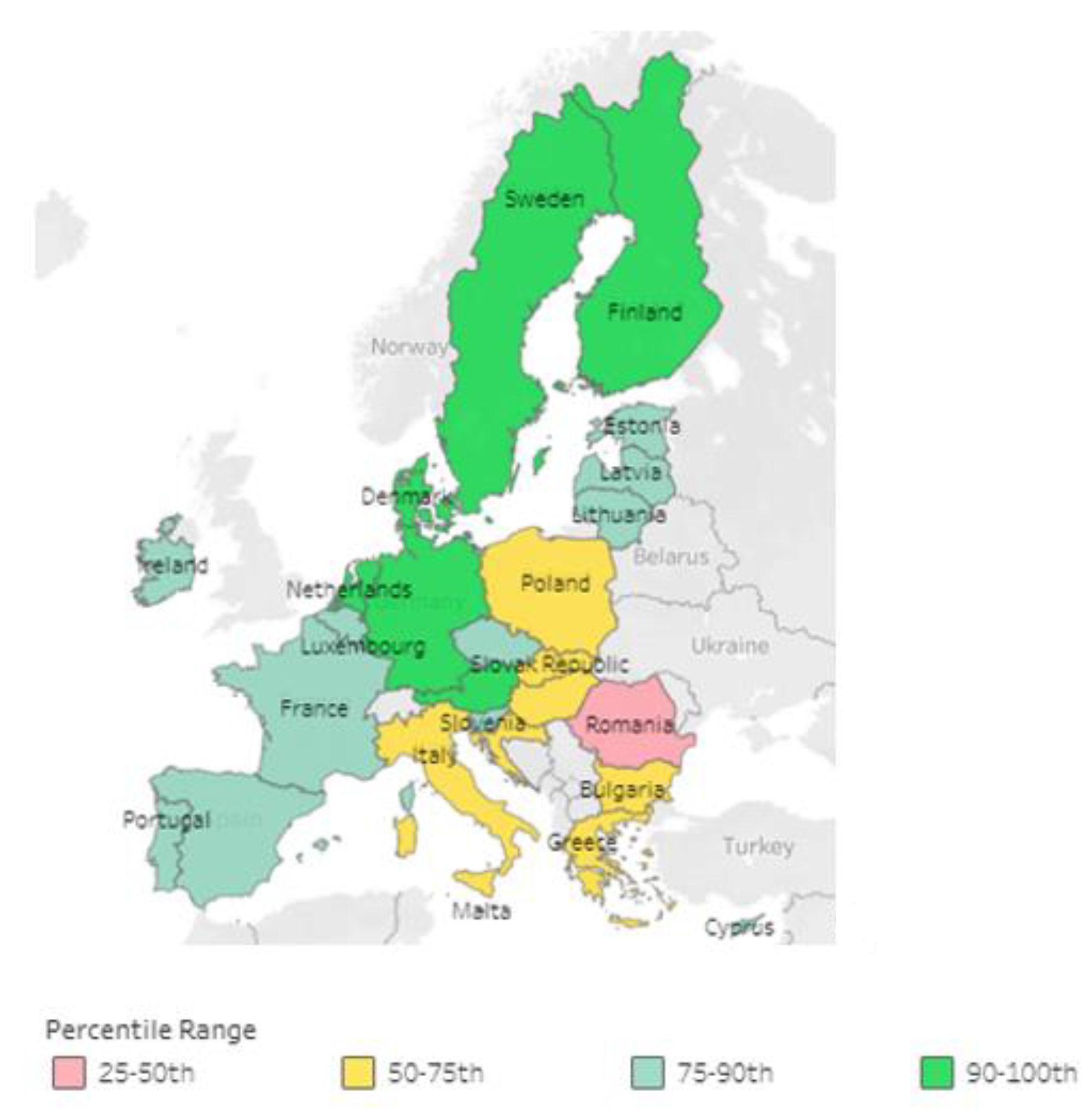
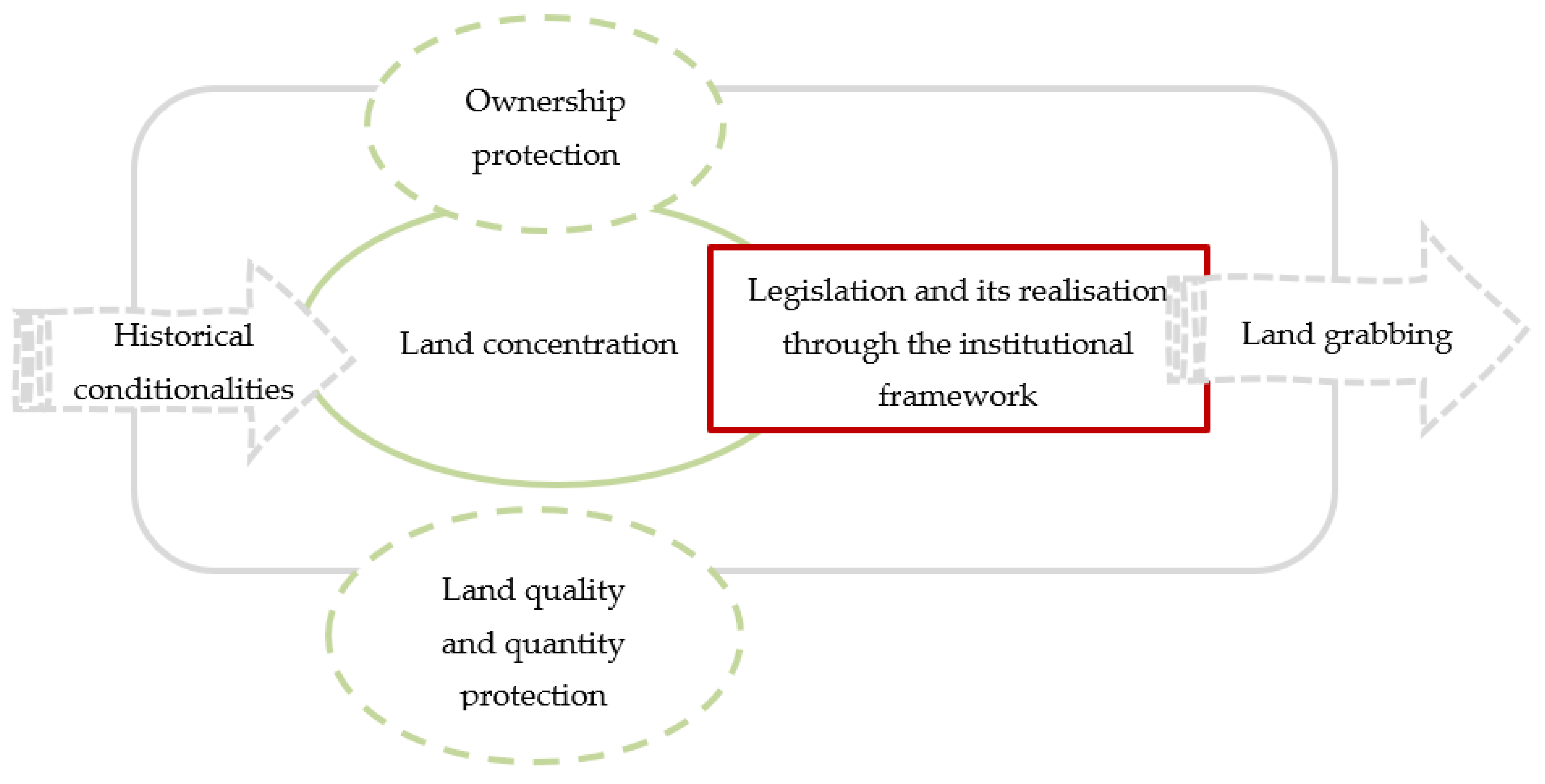

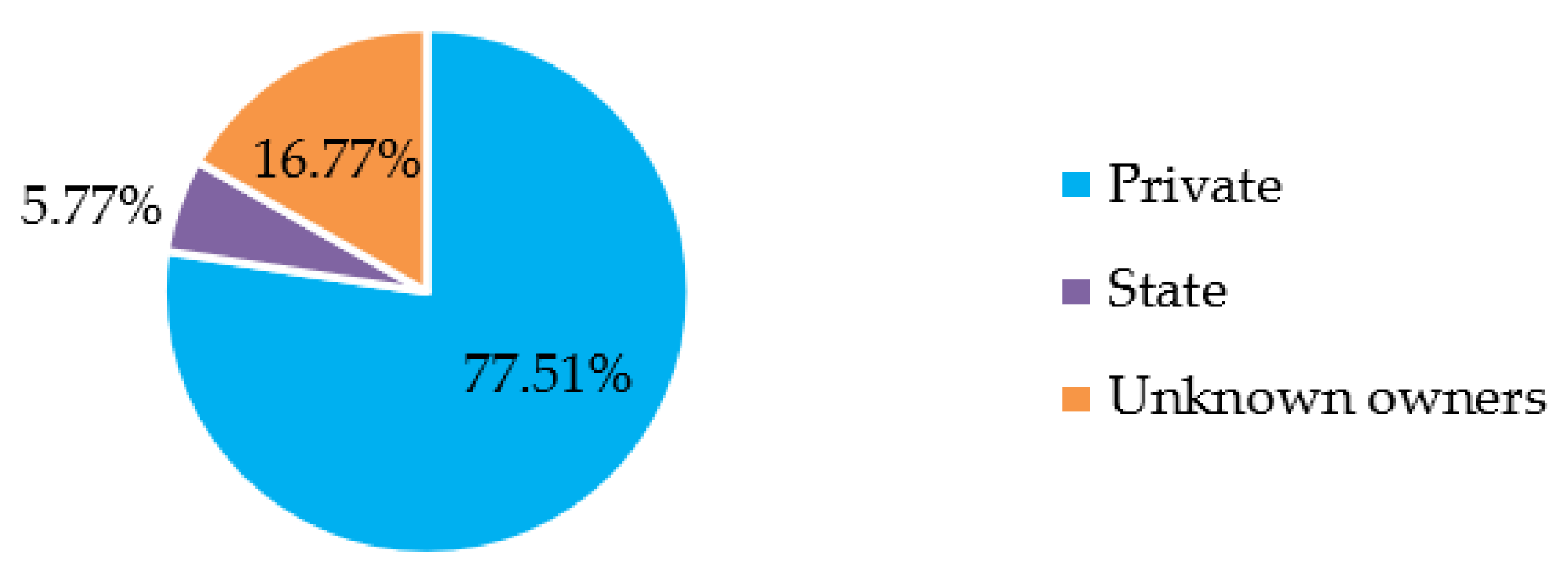
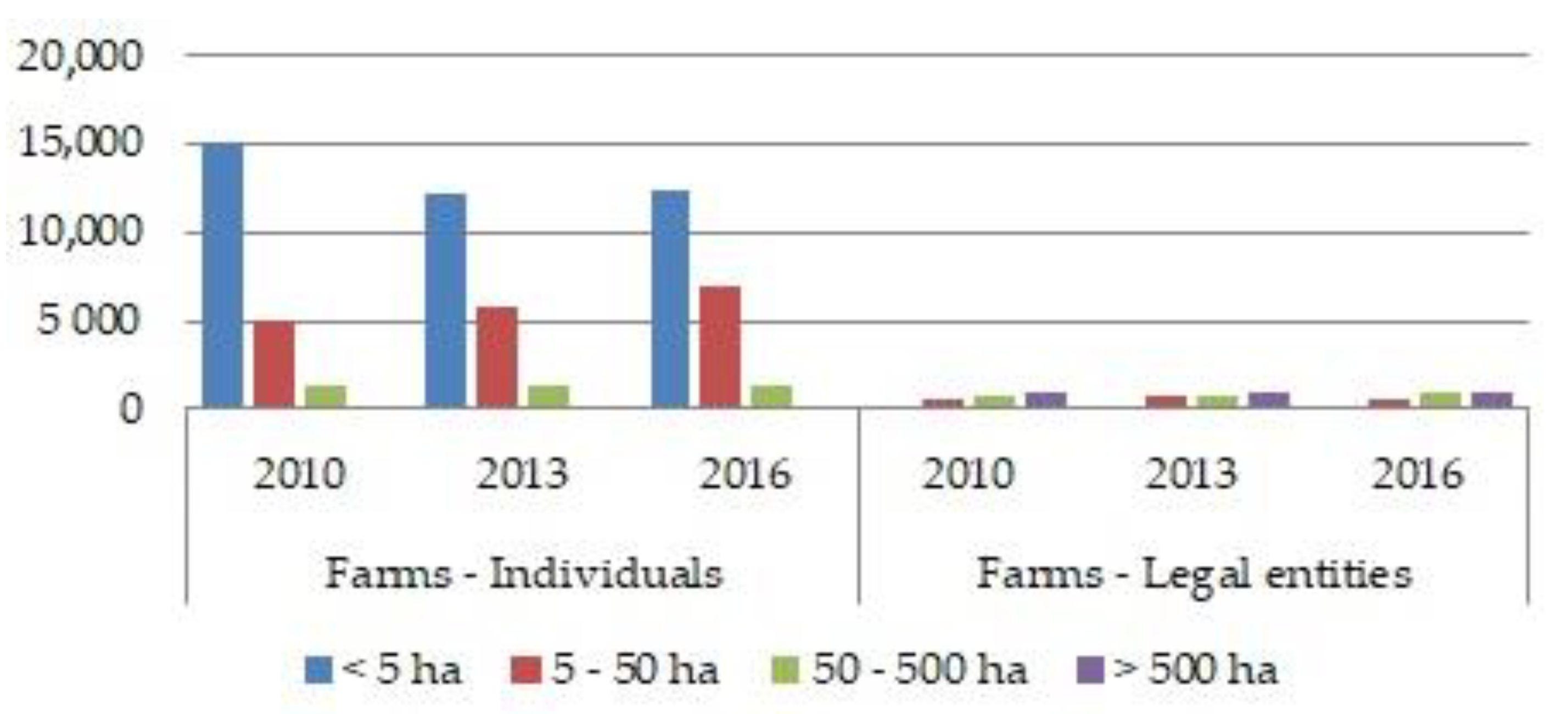
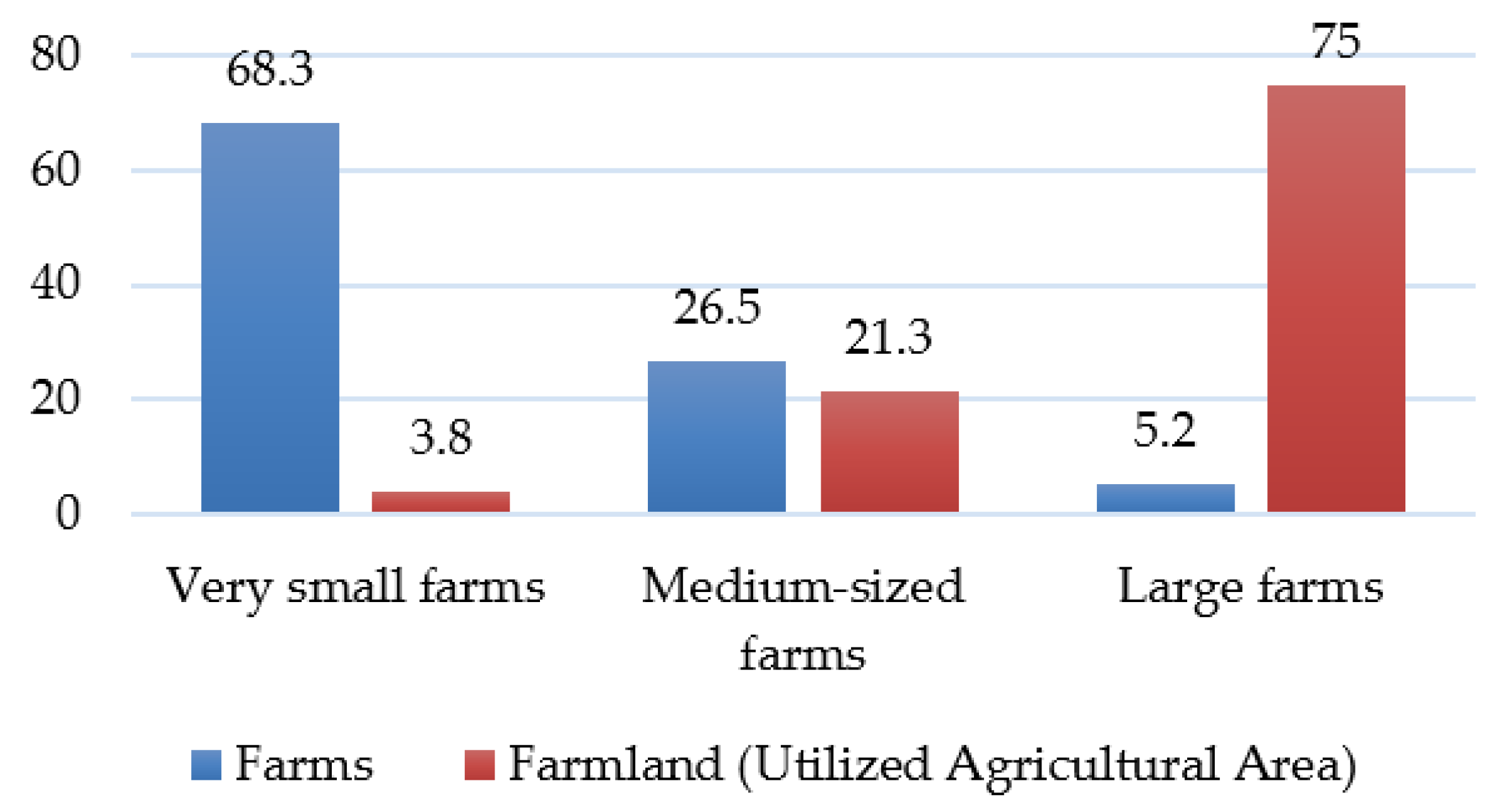
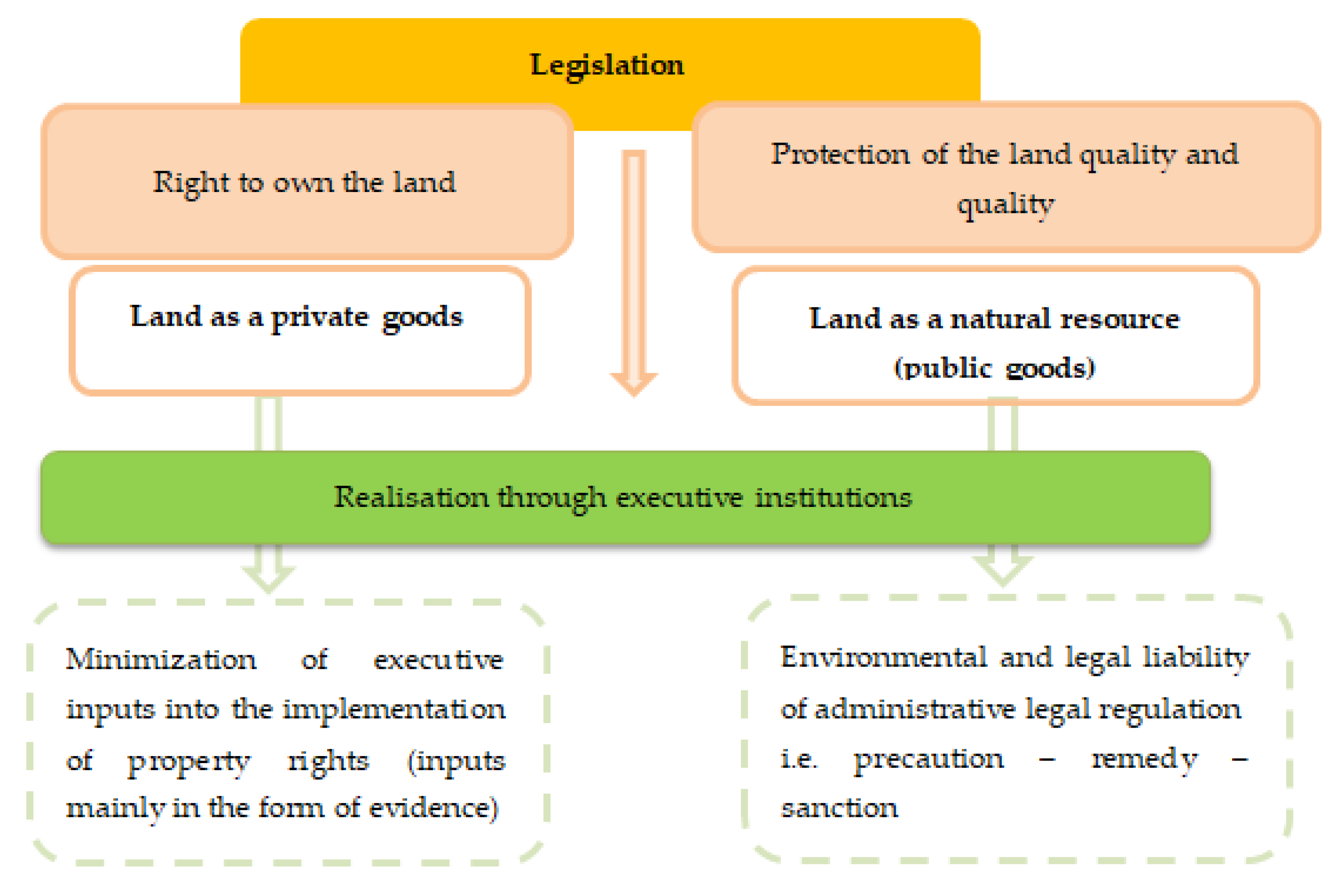


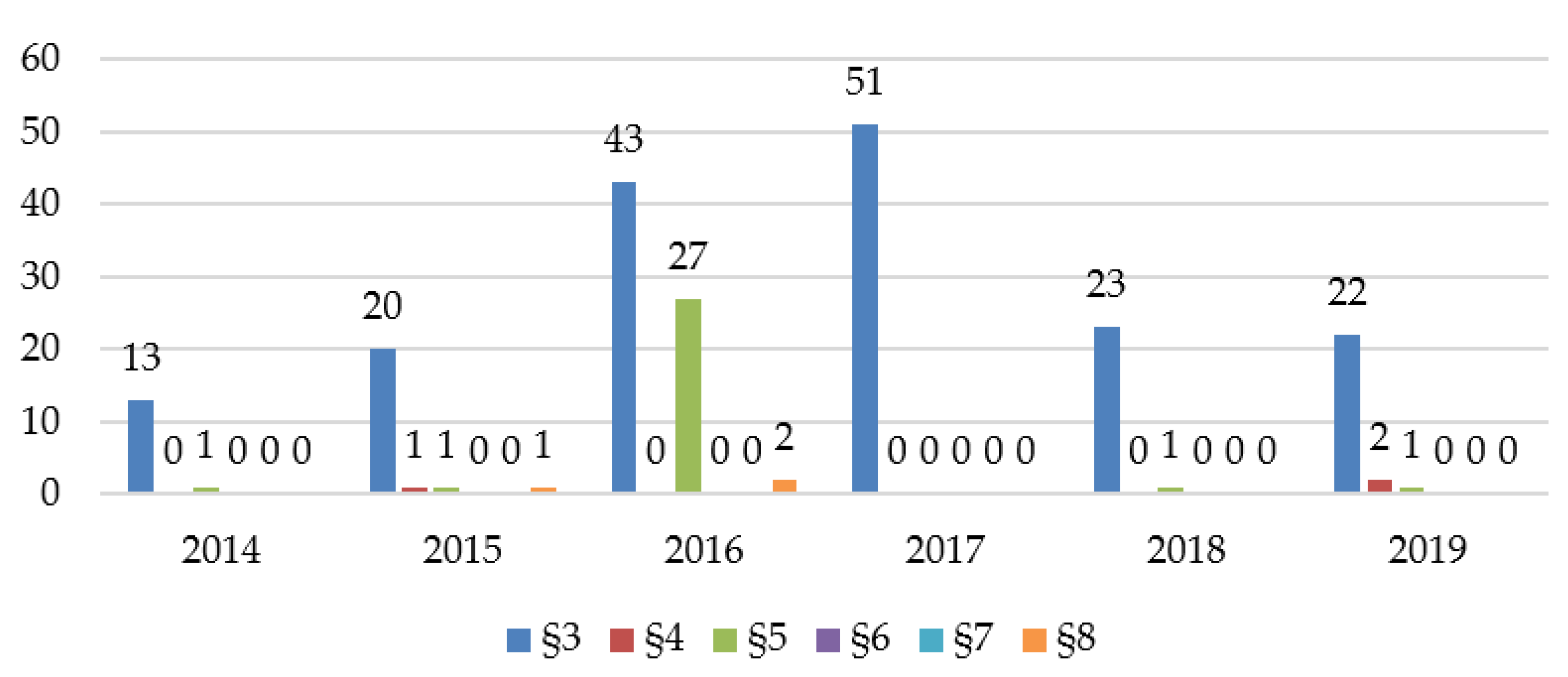
Publisher’s Note: MDPI stays neutral with regard to jurisdictional claims in published maps and institutional affiliations. |
© 2021 by the authors. Licensee MDPI, Basel, Switzerland. This article is an open access article distributed under the terms and conditions of the Creative Commons Attribution (CC BY) license (https://creativecommons.org/licenses/by/4.0/).
Share and Cite
Palšová, L.; Bandlerová, A.; Machničová, Z. Land Concentration and Land Grabbing Processes—Evidence from Slovakia. Land 2021, 10, 873. https://doi.org/10.3390/land10080873
Palšová L, Bandlerová A, Machničová Z. Land Concentration and Land Grabbing Processes—Evidence from Slovakia. Land. 2021; 10(8):873. https://doi.org/10.3390/land10080873
Chicago/Turabian StylePalšová, Lucia, Anna Bandlerová, and Zina Machničová. 2021. "Land Concentration and Land Grabbing Processes—Evidence from Slovakia" Land 10, no. 8: 873. https://doi.org/10.3390/land10080873
APA StylePalšová, L., Bandlerová, A., & Machničová, Z. (2021). Land Concentration and Land Grabbing Processes—Evidence from Slovakia. Land, 10(8), 873. https://doi.org/10.3390/land10080873




